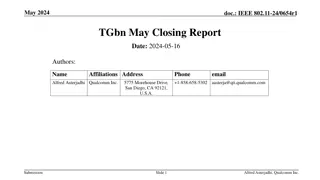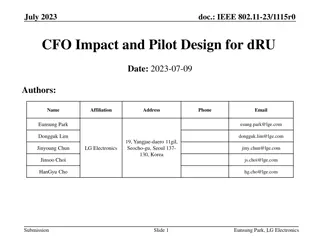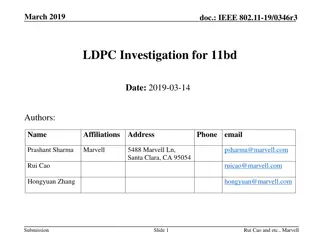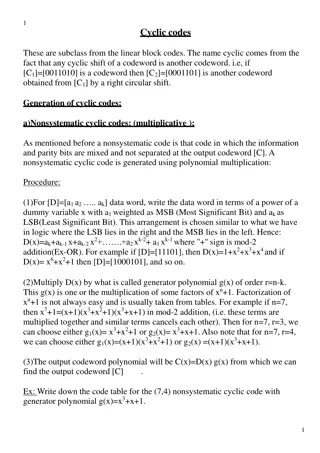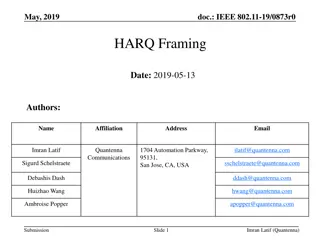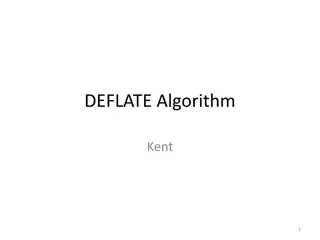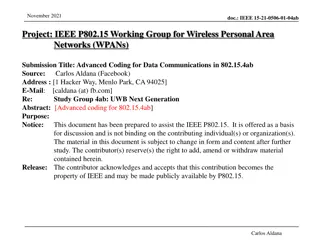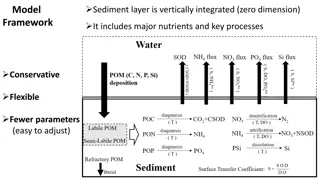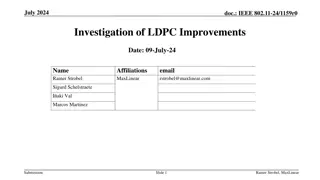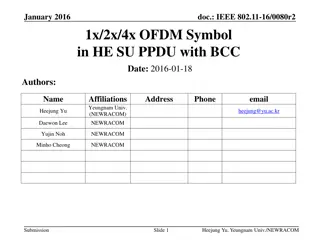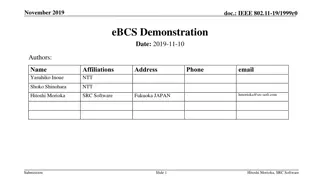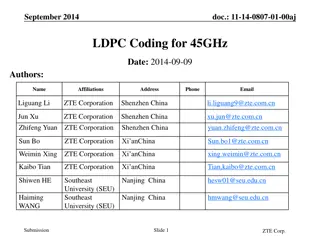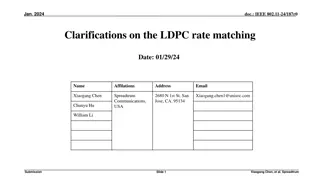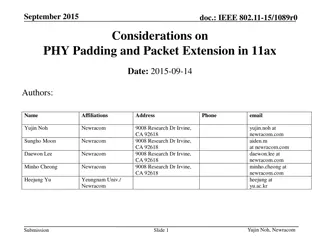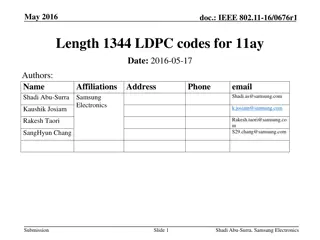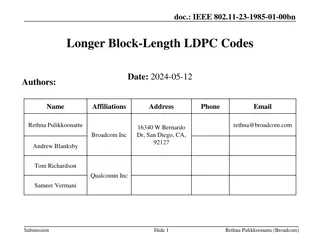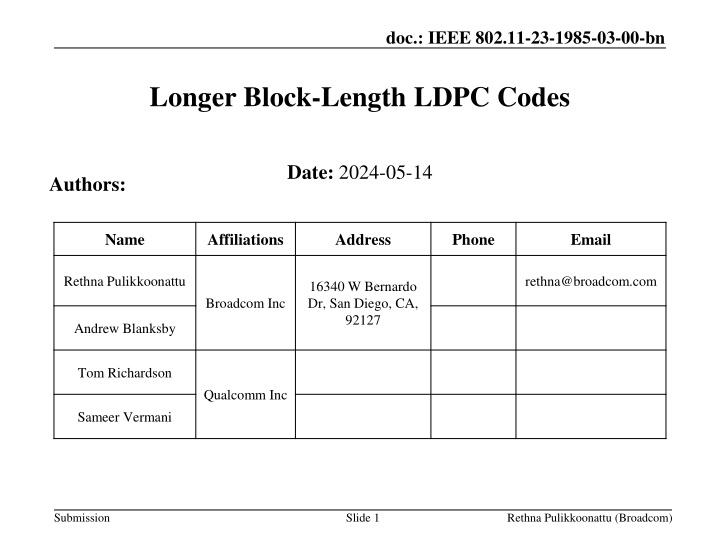
Enhancing WiFi Error Correction with Longer LDPC Codes
"Explore the proposal for longer Low-Density-Parity-Check (LDPC) codes in IEEE 802.11be standard, offering improved performance in WiFi communication scenarios. Learn about the benefits, construction, and potential gains of 2x longer LDPC codes compared to existing ones."
Download Presentation

Please find below an Image/Link to download the presentation.
The content on the website is provided AS IS for your information and personal use only. It may not be sold, licensed, or shared on other websites without obtaining consent from the author. If you encounter any issues during the download, it is possible that the publisher has removed the file from their server.
You are allowed to download the files provided on this website for personal or commercial use, subject to the condition that they are used lawfully. All files are the property of their respective owners.
The content on the website is provided AS IS for your information and personal use only. It may not be sold, licensed, or shared on other websites without obtaining consent from the author.
E N D
Presentation Transcript
doc.: IEEE 802.11-23-1985-03-00-bn Longer Block-Length LDPC Codes Date: 2024-05-14 Authors: Name Affiliations Address Phone Email Rethna Pulikkoonattu rethna@broadcom.com 16340 W Bernardo Dr, San Diego, CA, 92127 Broadcom Inc Andrew Blanksby Tom Richardson Qualcomm Inc Sameer Vermani Submission Slide 1 Rethna Pulikkoonattu (Broadcom)
doc.: IEEE 802.11-23-1985-03-00-bn Introduction This submission proposes Low-Density-Parity-Check (LDPC) codes with a block length of 3888 bits (2x1944) for UHR Support all the 4 code rates defined in 802.11be Outline of the slides High level reasoning for proposing 2x longer LDPC codes Birds eye view of the proposal Performance comparisons between the longer codes and existing codes Considerable performance improvements in various communication scenarios Even larger performance gains in the presence of RF impairments for high data rates Code construction based on lifting Basic idea of lifting Details of code definition Exponent matrix and parity matrix details Show how the approach allows reuse of existing encoding/decoding architectures Conclusions Submission Slide 2 Rethna Pulikkoonattu (Broadcom)
doc.: IEEE 802.11-23-1985-03-00-bn Why a 2x longer LDPC code? LDPC codes has been the backbone error correction coding scheme for WiFi for over 15 years Longest LDPC code specified so far has block length=1944 bits Performance wise, about 2.7dB away from the optimum random codes (e.g., BICM-AWGN-QAM R=5/6 limits). Since the TGn amendments, data rates have surged significantly due to expansions in MIMO dimensions, modulation size (from 64QAM to 4096QAM), and bandwidth (from 40MHz to 320MHz), along with higher aggregations, all requiring enhanced coding performance. Pitch for longer block-length codes Long block length random codes lead to enhanced coding gains, in accordance with the finite-length scaling laws [1,2] Deterministic codes, which are suboptimal, exhibit scaling gains that are significantly larger than those of optimal random codes, (In AWGN a doubling effect is known to be true [1], see figure 12 in [1]). The performance vs complexity trade off suggests that block- length of 2x1944 bits is a sweet spot Slide 3 Submission Rethna Pulikkoonattu (Broadcom)
doc.: IEEE 802.11-23-1985-03-00-bn Proposal for 2x longer codes: Birds eye view Maintain the base structure of the 802.11be code, quasi-cyclic- LDPC (QC-LDPC) specifically, unchanged Facilitate the reutilization of existing hardware blocks in implementations Empower parallel encoding and decoding functionalities Demonstrable gains across the board (channels, PHY bandwidth, MIMO, MCS, Transmit Beamforming) Provides 0.5-1.0dB gains over the present 802.11 LDPC codes, depending on the channel conditions Larger gains for high data rates with Tx/Rx impairments Encoding and decoding The code's design allows for the potential parallelism in both encoding and decoding, using existing hardware blocks of 1944 bits Submission Slide 4 Rethna Pulikkoonattu (Broadcom)
doc.: IEEE 802.11-23-1985-03-00-bn Simulation Performance (1x1) Conditions 1x1, AWGN,D-NLOS,BLOS Linear Demapper No RF-impairments 5000 channel realizations SNR ref @ PER=1% Near ideal channel estimation Decoder Layered BP,max 20 iterations Packet Length is varied to budget adequate number of codewords and symbols Submission Rethna Pulikkoonattu (Broadcom) Slide 5
doc.: IEEE 802.11-23-1985-03-00-bn Simulation Performance (MIMO 2x2) Conditions 2x2x2 MIMO TxBF=OFF Reduced complexity ~ML demapper No RF-impairments 5000 channel realizations SNR ref @ PER=1% Near ideal channel estimation Channels D-NLOS,B-LOS Decoder Layered BP max 20 iterations Submission Rethna Pulikkoonattu (Broadcom) Slide 6
doc.: IEEE 802.11-23-1985-03-00-bn Simulation Performance (MIMO 4x2 TxBF) Conditions 4x2x2 MIMO TxBF=SVD Linear demapper No RF-impairments 5000 channel realizations SNR ref @ PER=1% Near ideal channel estimation Channels D-NLOS, B-LOS Decoder Layered BP max 20 iterations Submission Rethna Pulikkoonattu (Broadcom) Slide 7
doc.: IEEE 802.11-23-1985-03-00-bn Results with Impairments for High Data Rates Now, we show performance gains of 2x LDPC with impairments Focus on high data rates Simulation assumptions Full fledged implementation (realistic Tx/Rx impairments, tracking loops, channel Est) RF Impairments modeled PLL Phase Noise, IQ imbalance, DC offset, CFO, Non-Linearity Detector 4x2 has SVD precoding and at the receiver a linear de-mapper is used 2x2 and 4x4 results (in Appendix) are with a low complexity ML detector LDPC Decoder Max Iteration = 20 Layered min-sum variant Other assumptions Packet size is varied to budget adequate number of codewords and symbols 1000 independent channel realizations GI=1.6uS Submission Rethna Pulikkoonattu (Broadcom) Slide 8
doc.: IEEE 802.11-23-1985-03-00-bn 320MHz MIMO 4x2 D-NLOS: MCS 10-13 RF Impairments Phase Noise, IQ imbalance, CFO, DC offset, PA Non-Linearity Tx and Rx have identical impairment profiles Submission Rethna Pulikkoonattu (Broadcom) Slide 9
doc.: IEEE 802.11-23-1985-03-00-bn Remarks on the gains in the presence of impairments Greater gains are realized in a practical scenario characterized by limitations imposed by RF impairments 0.5 to 1 dB improvement in decoding SNR can translate to a huge overall gain in an impairment limited scenario and can in some cases even lead to removal of error floor The 2x1944 code offers effective pathways to ensure full functionality of MCS10-13 across a broad spectrum of scenarios Improved reliability of higher MCSs Submission Slide 10 Rethna Pulikkoonattu (Broadcom)
doc.: IEEE 802.11-23-1985-03-00-bn Outline of the Code Design: Protograph Lifting Start with a graph corresponding to blocklength=1944 Code Base graph is lifted by 2. Edges are then permuted using graph optimization techniques, specifically avoiding problematic short cycles (design goal is girth 6) and trapping sets. Further fine tuning is achieved by modifying graphs to improve decoding threshold and error floor, while retaining the lifting framework Illustration of the proto-lifting with a toy example Submission Rethna Pulikkoonattu (Broadcom) Slide 11
doc.: IEEE 802.11-23-1985-03-00-bn 2x1944 LDPC Code Definition Define the exponent matrix E(H) of size 48(1-R) x 48 . The parity check matrix H is obtained by simply following the cyclic shifting procedure on identity matrix of size Z=81. Keep the matrix interpretation consistent with the existing codes (i.e., cyclic shifted structure) in the IEEE specification Submission Slide 12 Rethna Pulikkoonattu (Broadcom)
doc.: IEEE 802.11-23-1985-03-00-bn Parallelism in Decoding Two decoders working on 1944 block runs concurrently The cross-layer message passing will go through the connected edges (represented by the diagonal cross; corresponding to circulant matrix) This is possible due to the sub-matrix structure (2x2 circulant matrices) Note: The general idea here is that, in the process of message passing based decoding on graphs, two graphs can be run in parallel. At certain fixed node positions (e.g., when the connection is off- diagonal), the exchange of information can be switched in a fixed manner. Submission Rethna Pulikkoonattu (Broadcom) Slide 13
doc.: IEEE 802.11-23-1985-03-00-bn Parallelism in Decoding(ctd..) Message Passing and check node computation procedures unchanged, except for the appropriate swapping of the edges in the graph. Submission Rethna Pulikkoonattu (Broadcom) Slide 14
doc.: IEEE 802.11-23-1985-03-00-bn Parallelism in Decoding(ctd..) Message passing is performed on these factor graphs [4] simultaneously. Submission Rethna Pulikkoonattu (Broadcom) Slide 15
doc.: IEEE 802.11-23-1985-03-00-bn Conclusions LDPC codes with longer block lengths consistently provide enhanced performance gains 2x1944 offers gains in the range 0.5-1.0dB in low-medium MCS Much larger gains in high MCS situations which are often limited by RF impairment limits These codes offers effective pathways to ensure full functionality of MCS10-13 across a broad spectrum of scenarios Proposed code structure facilitates parallelism in both encoding and decoding Manageable implementation cost of 2x1944 LDPC codes in both STA and AP devices We believe this can be a differentiating feature for UHR, strengthening the high reliability aspect of the link Submission Slide 16 Rethna Pulikkoonattu (Broadcom)
doc.: IEEE 802.11-23-1985-03-00-bn Straw-Poll 1 Do you support adopting 2x1944 length LDPC codes for UHR? Submission Slide 17 Rethna Pulikkoonattu (Broadcom)
doc.: IEEE 802.11-23-1985-03-00-bn References Polyanskiy, Y., Poor, H.V. and Verd , S., 2010. Channel coding rate in the finite blocklength regime. IEEE Transactions on Information Theory, 56(5), pp.2307-2359. Yang, W., Durisi, G., Koch, T. and Polyanskiy, Y., 2014. Quasi-static multiple-antenna fading channels at finite blocklength. IEEE Transactions on Information Theory, 60(7), pp.4232-4265. Richardson, T., 2003, October. Error floors of LDPC codes. In Proceedings of the annual Allerton conference on communication control and computing (Vol. 41, No. 3, pp. 1426-1435). The University; 1998. Richardson, T. and Urbanke, R., 2008. Modern coding theory. Cambridge university press. 1. 2. 3. 4. Submission Slide 18 Rethna Pulikkoonattu (Broadcom)
doc.: IEEE 802.11-23-1985-03-00-bn Appendix Submission Slide 19 Rethna Pulikkoonattu (Broadcom)
doc.: IEEE 802.11-23-1985-03-00-bn Random Coding vs LDPC: Finite Length Bounds Finite Length scaling gain (Random codes versus LDPC codes). Suboptimal Codes exhibit larger scaling gains than random codes [2]) Gain ~ 0.5-0.8dB vs RCU bounds (0.2-0.3)dB AWGN. Higher gain and bigger gap on D-NLOS channels Suboptimality of the code Frequency diversity (interleaving) Finite blocklength scaling Submission Rethna Pulikkoonattu (Broadcom) Slide 20
doc.: IEEE 802.11-23-1985-03-00-bn 3888-LDPC E(H): R=5/6 [13,-1,-1,48,-1,80,-1,66,-1,4,74,-1,7,-1,-1,30,76,-1,-1,52,37,-1,-1,60,-1,-1,-1,49,73,-1,31,-1,-1,74,73,-1,-1,23,-1,-1,1,-1,0,-1,-1,-1,-1,-1 -1,13,48,-1,80,-1,66,-1,4,-1,-1,74,-1,7,30,-1,-1,76,52,-1,-1,37,60,-1,-1,-1,49,-1,-1,73,-1,31,74,-1,-1,73,23,-1,-1,-1,-1,1,-1,0,-1,-1,-1,-1 -1,69,-1,63,-1,74,56,-1,64,-1,-1,77,57,-1,-1,65,6,-1,-1,16,-1,51,-1,-1,64,-1,-1,-1,68,-1,-1,9,48,-1,-1,62,54,-1,27,-1,-1,-1,0,-1,0,-1,-1,-1 69,-1,63,-1,74,-1,-1,56,-1,64,77,-1,-1,57,65,-1,-1,6,16,-1,51,-1,-1,-1,-1,64,-1,-1,-1,68,9,-1,-1,48,62,-1,-1,54,-1,27,-1,-1,-1,0,-1,0,-1,-1 51,-1,15,-1,-1,0,-1,80,-1,24,-1,25,-1,42,54,-1,-1,44,71,-1,71,-1,-1,9,67,-1,-1,35,-1,-1,-1,58,-1,-1,-1,29,-1,-1,53,-1,0,-1,-1,-1,0,-1,0,-1 -1,51,-1,15,0,-1,80,-1,24,-1,25,-1,42,-1,-1,54,44,-1,-1,71,-1,71,9,-1,-1,67,35,-1,-1,-1,58,-1,-1,-1,29,-1,-1,-1,-1,53,-1,0,-1,-1,-1,0,-1,0 -1,16,29,-1,36,-1,-1,41,-1,44,56,-1,-1,59,-1,37,-1,50,24,-1,-1,-1,-1,65,4,-1,65,-1,52,-1,-1,-1,4,-1,-1,-1,-1,73,-1,52,1,-1,-1,-1,-1,-1,0,-1 16,-1,-1,29,-1,36,41,-1,44,-1,-1,56,59,-1,37,-1,50,-1,-1,24,-1,-1,65,-1,-1,4,-1,65,-1,52,-1,-1,-1,4,-1,-1,73,-1,52,-1,-1,1,-1,-1,-1,-1,-1,0] Submission Rethna Pulikkoonattu (Broadcom) Slide 21
doc.: IEEE 802.11-23-1985-03-00-bn 3888-LDPC E(H): R=3/4 [48,-1,-1,29,28,-1,39,-1,9,-1,61,-1,-1,-1,-1,-1,-1,-1,63,-1,45,-1,-1,80,-1,-1,-1,-1,-1,-1,37,-1,-1,32,-1,22,1,-1,0,-1,-1,-1,-1,-1,-1,-1,-1,-1 -1,48,29,-1,-1,28,-1,39,-1,9,-1,61,-1,-1,-1,-1,-1,-1,-1,63,-1,45,80,-1,-1,-1,-1,-1,-1,-1,-1,37,32,-1,22,-1,-1,1,-1,0,-1,-1,-1,-1,-1,-1,-1,-1 4,-1,49,-1,-1,42,-1,48,11,-1,-1,30,-1,-1,-1,-1,-1,-1,49,-1,-1,17,41,-1,37,-1,-1,15,-1,-1,54,-1,-1,-1,-1,-1,-1,-1,0,-1,0,-1,-1,-1,-1,-1,-1,-1 -1,4,-1,49,42,-1,48,-1,-1,11,30,-1,-1,-1,-1,-1,-1,-1,-1,49,17,-1,-1,41,-1,37,15,-1,-1,-1,-1,54,-1,-1,-1,-1,-1,-1,-1,0,-1,0,-1,-1,-1,-1,-1,-1 -1,35,-1,76,78,-1,51,-1,37,-1,35,-1,21,-1,-1,-1,-1,17,64,-1,-1,-1,-1,-1,-1,-1,59,-1,7,-1,-1,-1,-1,-1,-1,32,-1,-1,-1,-1,0,-1,0,-1,-1,-1,-1,-1 35,-1,76,-1,-1,78,-1,51,-1,37,-1,35,-1,21,-1,-1,17,-1,-1,64,-1,-1,-1,-1,-1,-1,-1,59,-1,7,-1,-1,-1,-1,32,-1,-1,-1,-1,-1,-1,0,-1,0,-1,-1,-1,-1 9,-1,-1,65,44,-1,9,-1,-1,54,-1,56,73,-1,-1,34,42,-1,-1,-1,-1,-1,-1,-1,-1,35,-1,-1,-1,-1,-1,-1,46,-1,-1,39,0,-1,-1,-1,-1,-1,0,-1,0,-1,-1,-1 -1,9,65,-1,-1,44,-1,9,54,-1,56,-1,-1,73,34,-1,-1,42,-1,-1,-1,-1,-1,-1,35,-1,-1,-1,-1,-1,-1,-1,-1,46,39,-1,-1,0,-1,-1,-1,-1,-1,0,-1,0,-1,-1 -1,3,62,-1,-1,7,-1,80,-1,68,-1,26,-1,-1,-1,80,55,-1,-1,-1,36,-1,-1,-1,-1,26,-1,-1,9,-1,-1,-1,-1,72,-1,-1,-1,-1,-1,-1,-1,-1,-1,-1,0,-1,0,-1 3,-1,-1,62,7,-1,80,-1,68,-1,26,-1,-1,-1,80,-1,-1,55,-1,-1,-1,36,-1,-1,26,-1,-1,-1,-1,9,-1,-1,72,-1,-1,-1,-1,-1,-1,-1,-1,-1,-1,-1,-1,0,-1,0 -1,26,-1,75,33,-1,21,-1,69,-1,59,-1,3,-1,-1,38,-1,-1,-1,-1,-1,-1,35,-1,-1,-1,-1,62,36,-1,-1,26,-1,-1,-1,-1,1,-1,-1,-1,-1,-1,-1,-1,-1,-1,0,-1 26,-1,75,-1,-1,33,-1,21,-1,69,-1,59,-1,3,38,-1,-1,-1,-1,-1,-1,-1,-1,35,-1,-1,62,-1,-1,36,26,-1,-1,-1,-1,-1,-1,1,-1,-1,-1,-1,-1,-1,-1,-1,-1,0] Submission Rethna Pulikkoonattu (Broadcom) Slide 22
doc.: IEEE 802.11-23-1985-03-00-bn 3888-LDPC E(H): R=2/3 [61,-1,75,-1,4,-1,63,-1,-1,56,-1,-1,-1,-1,-1,-1,-1,-1,-1,-1,-1,-1,8,-1,-1,-1,-1,2,-1,17,25,-1,1,-1,0,-1,-1,-1,-1,-1,-1,-1,-1,-1,-1,-1,-1,-1 -1,61,-1,75,-1,4,-1,63,56,-1,-1,-1,-1,-1,-1,-1,-1,-1,-1,-1,-1,-1,-1,8,-1,-1,2,-1,17,-1,-1,25,-1,1,-1,0,-1,-1,-1,-1,-1,-1,-1,-1,-1,-1,-1,-1 -1,56,-1,74,77,-1,20,-1,-1,-1,-1,-1,-1,-1,64,-1,24,-1,-1,4,-1,67,-1,-1,-1,7,-1,-1,-1,-1,-1,-1,-1,-1,0,-1,0,-1,-1,-1,-1,-1,-1,-1,-1,-1,-1,-1 56,-1,74,-1,-1,77,-1,20,-1,-1,-1,-1,-1,-1,-1,64,-1,24,4,-1,67,-1,-1,-1,7,-1,-1,-1,-1,-1,-1,-1,-1,-1,-1,0,-1,0,-1,-1,-1,-1,-1,-1,-1,-1,-1,-1 28,-1,21,-1,68,-1,-1,10,7,-1,14,-1,65,-1,-1,-1,-1,-1,-1,-1,23,-1,-1,-1,-1,-1,-1,-1,-1,75,-1,-1,-1,-1,-1,-1,0,-1,0,-1,-1,-1,-1,-1,-1,-1,-1,-1 -1,28,-1,21,-1,68,10,-1,-1,7,-1,14,-1,65,-1,-1,-1,-1,-1,-1,-1,23,-1,-1,-1,-1,-1,-1,75,-1,-1,-1,-1,-1,-1,-1,-1,0,-1,0,-1,-1,-1,-1,-1,-1,-1,-1 -1,48,38,-1,43,-1,78,-1,76,-1,-1,-1,-1,-1,-1,-1,-1,-1,5,-1,36,-1,-1,-1,15,-1,72,-1,-1,-1,-1,-1,-1,-1,-1,-1,-1,-1,0,-1,0,-1,-1,-1,-1,-1,-1,-1 48,-1,-1,38,-1,43,-1,78,-1,76,-1,-1,-1,-1,-1,-1,-1,-1,-1,5,-1,36,-1,-1,-1,15,-1,72,-1,-1,-1,-1,-1,-1,-1,-1,-1,-1,-1,0,-1,0,-1,-1,-1,-1,-1,-1 40,-1,2,-1,-1,53,-1,25,-1,-1,-1,52,62,-1,-1,-1,20,-1,-1,-1,-1,-1,-1,44,-1,-1,-1,-1,-1,-1,-1,-1,0,-1,-1,-1,-1,-1,-1,-1,0,-1,0,-1,-1,-1,-1,-1 -1,40,-1,2,53,-1,25,-1,-1,-1,52,-1,-1,62,-1,-1,-1,20,-1,-1,-1,-1,44,-1,-1,-1,-1,-1,-1,-1,-1,-1,-1,0,-1,-1,-1,-1,-1,-1,-1,0,-1,0,-1,-1,-1,-1 69,-1,-1,23,64,-1,10,-1,22,-1,-1,-1,21,-1,-1,-1,-1,-1,-1,-1,-1,-1,-1,-1,-1,68,-1,23,-1,29,-1,-1,-1,-1,-1,-1,-1,-1,-1,-1,-1,-1,0,-1,0,-1,-1,-1 -1,69,23,-1,-1,64,-1,10,-1,22,-1,-1,-1,21,-1,-1,-1,-1,-1,-1,-1,-1,-1,-1,68,-1,23,-1,29,-1,-1,-1,-1,-1,-1,-1,-1,-1,-1,-1,-1,-1,-1,0,-1,0,-1,-1 12,-1,-1,0,-1,68,-1,20,55,-1,61,-1,-1,-1,40,-1,-1,-1,-1,-1,-1,-1,-1,52,-1,-1,-1,-1,-1,-1,44,-1,-1,-1,-1,-1,-1,-1,-1,-1,-1,-1,-1,-1,0,-1,0,-1 -1,12,0,-1,68,-1,20,-1,-1,55,-1,61,-1,-1,-1,40,-1,-1,-1,-1,-1,-1,52,-1,-1,-1,-1,-1,-1,-1,-1,44,-1,-1,-1,-1,-1,-1,-1,-1,-1,-1,-1,-1,-1,0,-1,0 -1,58,-1,8,-1,34,-1,64,-1,78,-1,-1,-1,-1,11,-1,-1,78,24,-1,-1,-1,-1,-1,-1,-1,-1,-1,-1,-1,-1,58,1,-1,-1,-1,-1,-1,-1,-1,-1,-1,-1,-1,-1,-1,0,-1 58,-1,8,-1,34,-1,64,-1,78,-1,-1,-1,-1,-1,-1,11,78,-1,-1,24,-1,-1,-1,-1,-1,-1,-1,-1,-1,-1,58,-1,-1,1,-1,-1,-1,-1,-1,-1,-1,-1,-1,-1,-1,-1,-1,0] Submission Rethna Pulikkoonattu (Broadcom) Slide 23
doc.: IEEE 802.11-23-1985-03-00-bn 3888-LDPC E(H): R=1/2 [-1,57,-1,-1,-1,-1,-1,-1,-1,50,-1,-1,11,-1,-1,-1,50,-1,-1,-1,-1,79,-1,-1,1,-1,0,-1,-1,-1,-1,-1,-1,-1,-1,-1,-1,-1,-1,-1,-1,-1,-1,-1,-1,-1,-1,-1 57,-1,-1,-1,-1,-1,-1,-1,50,-1,-1,-1,-1,11,-1,-1,-1,50,-1,-1,79,-1,-1,-1,-1,1,-1,0,-1,-1,-1,-1,-1,-1,-1,-1,-1,-1,-1,-1,-1,-1,-1,-1,-1,-1,-1,-1 -1,3,-1,-1,-1,28,-1,-1,-1,0,-1,-1,-1,-1,-1,-1,55,-1,-1,7,-1,-1,-1,-1,-1,-1,0,-1,0,-1,-1,-1,-1,-1,-1,-1,-1,-1,-1,-1,-1,-1,-1,-1,-1,-1,-1,-1 3,-1,-1,-1,28,-1,-1,-1,0,-1,-1,-1,-1,-1,-1,-1,-1,55,7,-1,-1,-1,-1,-1,-1,-1,-1,0,-1,0,-1,-1,-1,-1,-1,-1,-1,-1,-1,-1,-1,-1,-1,-1,-1,-1,-1,-1 30,-1,-1,-1,-1,-1,-1,-1,-1,24,37,-1,-1,-1,-1,-1,56,-1,-1,14,-1,-1,-1,-1,-1,-1,-1,-1,0,-1,0,-1,-1,-1,-1,-1,-1,-1,-1,-1,-1,-1,-1,-1,-1,-1,-1,-1 -1,30,-1,-1,-1,-1,-1,-1,24,-1,-1,37,-1,-1,-1,-1,-1,56,14,-1,-1,-1,-1,-1,-1,-1,-1,-1,-1,0,-1,0,-1,-1,-1,-1,-1,-1,-1,-1,-1,-1,-1,-1,-1,-1,-1,-1 62,-1,53,-1,-1,-1,-1,-1,-1,53,-1,-1,-1,-1,3,-1,35,-1,-1,-1,-1,-1,-1,-1,-1,-1,-1,-1,-1,-1,0,-1,0,-1,-1,-1,-1,-1,-1,-1,-1,-1,-1,-1,-1,-1,-1,-1 -1,62,-1,53,-1,-1,-1,-1,53,-1,-1,-1,-1,-1,-1,3,-1,35,-1,-1,-1,-1,-1,-1,-1,-1,-1,-1,-1,-1,-1,0,-1,0,-1,-1,-1,-1,-1,-1,-1,-1,-1,-1,-1,-1,-1,-1 -1,40,-1,-1,-1,-1,20,-1,66,-1,-1,-1,-1,-1,-1,22,-1,28,-1,-1,-1,-1,-1,-1,-1,-1,-1,-1,-1,-1,-1,-1,0,-1,0,-1,-1,-1,-1,-1,-1,-1,-1,-1,-1,-1,-1,-1 40,-1,-1,-1,-1,-1,-1,20,-1,66,-1,-1,-1,-1,22,-1,28,-1,-1,-1,-1,-1,-1,-1,-1,-1,-1,-1,-1,-1,-1,-1,-1,0,-1,0,-1,-1,-1,-1,-1,-1,-1,-1,-1,-1,-1,-1 0,-1,-1,-1,-1,-1,-1,-1,8,-1,-1,-1,42,-1,-1,-1,-1,50,-1,-1,-1,-1,8,-1,-1,-1,-1,-1,-1,-1,-1,-1,-1,-1,0,-1,0,-1,-1,-1,-1,-1,-1,-1,-1,-1,-1,-1 -1,0,-1,-1,-1,-1,-1,-1,-1,8,-1,-1,-1,42,-1,-1,50,-1,-1,-1,-1,-1,-1,8,-1,-1,-1,-1,-1,-1,-1,-1,-1,-1,-1,0,-1,0,-1,-1,-1,-1,-1,-1,-1,-1,-1,-1 69,-1,79,-1,79,-1,-1,-1,-1,-1,-1,-1,-1,56,-1,-1,52,-1,-1,-1,-1,-1,-1,-1,0,-1,-1,-1,-1,-1,-1,-1,-1,-1,-1,-1,0,-1,0,-1,-1,-1,-1,-1,-1,-1,-1,-1 -1,69,-1,79,-1,79,-1,-1,-1,-1,-1,-1,56,-1,-1,-1,-1,52,-1,-1,-1,-1,-1,-1,-1,0,-1,-1,-1,-1,-1,-1,-1,-1,-1,-1,-1,0,-1,0,-1,-1,-1,-1,-1,-1,-1,-1 65,-1,-1,-1,-1,-1,-1,-1,38,-1,57,-1,-1,-1,-1,-1,72,-1,-1,-1,27,-1,-1,-1,-1,-1,-1,-1,-1,-1,-1,-1,-1,-1,-1,-1,-1,-1,0,-1,0,-1,-1,-1,-1,-1,-1,-1 -1,65,-1,-1,-1,-1,-1,-1,-1,38,-1,57,-1,-1,-1,-1,-1,72,-1,-1,-1,27,-1,-1,-1,-1,-1,-1,-1,-1,-1,-1,-1,-1,-1,-1,-1,-1,-1,0,-1,0,-1,-1,-1,-1,-1,-1 -1,64,-1,-1,-1,-1,-1,-1,14,-1,52,-1,-1,-1,-1,-1,-1,30,-1,-1,-1,-1,-1,32,-1,-1,-1,-1,-1,-1,-1,-1,-1,-1,-1,-1,-1,-1,-1,-1,0,-1,0,-1,-1,-1,-1,-1 64,-1,-1,-1,-1,-1,-1,-1,-1,14,-1,52,-1,-1,-1,-1,30,-1,-1,-1,-1,-1,32,-1,-1,-1,-1,-1,-1,-1,-1,-1,-1,-1,-1,-1,-1,-1,-1,-1,-1,0,-1,0,-1,-1,-1,-1 -1,-1,-1,45,-1,-1,-1,70,0,-1,-1,-1,-1,-1,-1,-1,77,-1,9,-1,-1,-1,-1,-1,-1,-1,-1,-1,-1,-1,-1,-1,-1,-1,-1,-1,-1,-1,-1,-1,-1,-1,0,-1,0,-1,-1,-1 -1,-1,45,-1,-1,-1,70,-1,-1,0,-1,-1,-1,-1,-1,-1,-1,77,-1,9,-1,-1,-1,-1,-1,-1,-1,-1,-1,-1,-1,-1,-1,-1,-1,-1,-1,-1,-1,-1,-1,-1,-1,0,-1,0,-1,-1 2,-1,56,-1,-1,-1,-1,57,35,-1,-1,-1,-1,-1,-1,-1,-1,-1,-1,-1,12,-1,-1,-1,-1,-1,-1,-1,-1,-1,-1,-1,-1,-1,-1,-1,-1,-1,-1,-1,-1,-1,-1,-1,0,-1,0,-1 -1,2,-1,56,-1,-1,57,-1,-1,35,-1,-1,-1,-1,-1,-1,-1,-1,-1,-1,-1,12,-1,-1,-1,-1,-1,-1,-1,-1,-1,-1,-1,-1,-1,-1,-1,-1,-1,-1,-1,-1,-1,-1,-1,0,-1,0 -1,24,-1,-1,-1,61,-1,-1,-1,60,-1,-1,-1,-1,-1,27,51,-1,-1,-1,-1,-1,16,-1,1,-1,-1,-1,-1,-1,-1,-1,-1,-1,-1,-1,-1,-1,-1,-1,-1,-1,-1,-1,-1,-1,0,-1 24,-1,-1,-1,61,-1,-1,-1,60,-1,-1,-1,-1,-1,27,-1,-1,51,-1,-1,-1,-1,-1,16,-1,1,-1,-1,-1,-1,-1,-1,-1,-1,-1,-1,-1,-1,-1,-1,-1,-1,-1,-1,-1,-1,-1,0] Submission Rethna Pulikkoonattu (Broadcom) Slide 24
doc.: IEEE 802.11-23-1985-03-00-bn 160MHz MIMO 2x2 D-LOS: MCS 10-13 RF Impairments (Typical) Phase Noise, IQ imbalance, CFO, DC offset Tx and Rx have identical impairment profiles Submission Rethna Pulikkoonattu (Broadcom) Slide 25
doc.: IEEE 802.11-23-1985-03-00-bn 160MHz MIMO 2x2 D-LOS: 4096-QAM RF Impairments (Typical and Minimal) Typical: Phase Noise, IQ imbalance, CFO, DC offset Minimal: Very low noise Phase Noise profile (dominant noise) Submission Rethna Pulikkoonattu (Broadcom) Slide 26
doc.: IEEE 802.11-23-1985-03-00-bn 320MHz MIMO 2x2 D-LOS: MCS 10-13 RF Impairments (Typical) PLL Phase Noise, IQ imbalance, CFO, DC offset Tx and Rx have identical impairment profiles Submission Rethna Pulikkoonattu (Broadcom) Slide 27
doc.: IEEE 802.11-23-1985-03-00-bn 160MHz MIMO 4x4 D-NLOS Long Packets Length (10+ symbols) RF Impairments (Aggressive) Phase Noise, IQ imbalance, CFO, DC offset, NL Tx and Rx have identical impairment profiles Submission Rethna Pulikkoonattu (Broadcom) Slide 28


